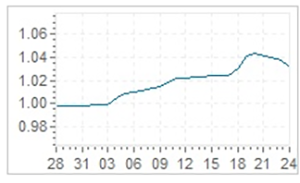
While all eyes are on interest rates in the Treasury market, an even more important global interest rate recently breached a key level for the first time since the financial crisis: the London Interbank Offered Rate (LIBOR). On December 29, 2016 LIBOR hit 1% for the first time in seven-and-a-half years.

I wrote back in October of last year, when LIBOR had reached 80 basis points, that a move up past 1% could spell trouble for the credit markets. We have now reached that point and are starting to see signs of strain on which we need to keep a close eye.
LIBOR is an uncannily accurate thermometer that measures the banking industry’s health: in normal times, low rates mean banks are doing well, while higher rates indicate reduced public confidence and a struggling industry. Right now, we are not living in normal times and it is more difficult than in the past to determine how to read market signals such as LIBOR. Nonetheless, LIBOR remains an incredibly important global benchmark and its rise will meaningfully increase borrowing costs across the global economy.
Corporate credit quality is deteriorating not only among junk borrowers but among investment grade companies that borrowed tens of billions of dollars to pay dividends and buy back overvalued shares. While the inability to earn a decent return on capital in fixed income markets poses enormous challenges for investors, outright losses are far more dangerous. And that is what they are facing if rates rise even modestly.
Here’s what to expect now that LIBOR has breached the 1% mark – and how you can profit.
What Rising LIBOR Means for You – And How to Profit
You may have heard about LIBOR because it was widely manipulated by bankers in London and New York before and during the financial crisis. A number of these individuals were prosecuted and several large banks paid huge fines to atone for their sins.
In order to understand LIBOR’s importance to the global financial system, it is important to understand the scale of its usage around the world. After widespread LIBOR manipulation was discovered, a new regime was put in place that seems to be working reasonably well. There are currently 38 clearing members in LIBOR in five major currencies (USD, EUR, GBP, JPY and CHF). These firms post rates for seven different LIBOR maturities in these currencies. The most widely used maturity is 3-month USD LIBOR. There are tens of trillions of dollars of debt and derivative contracts priced off this benchmark.
















